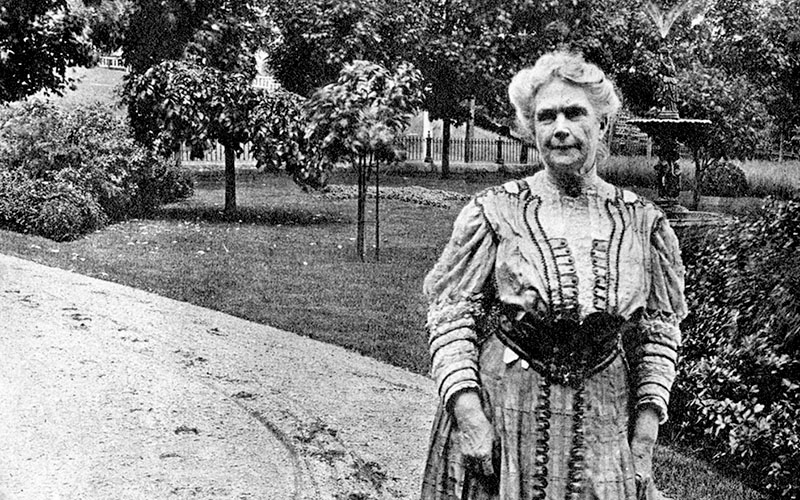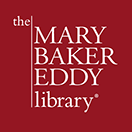Women of History: Sarah Jane Clark

Sarah Jane Clark, c. 1907. Photographer unknown. P00464.
Sarah Jane Clark (1839–1916) fostered the beginnings of Christian Science in Jamestown, New York, served as Editor of The Christian Science Journal1, and pioneered the establishment of Christian Science in Toledo, Ohio.2 She also served briefly on Mary Baker Eddy’s household staff.
Born in Griggsville, Illinois, she was the great granddaughter of John Clark, a Revolutionary War soldier. At the age of ten, she moved with her family to Jacksonville, Illinois, where two years later she lost both her mother and younger sister. Her father remarried and the family relocated to Massachusetts.3
Clark was introduced to Christian Science by a friend, who persuaded her to have Christian Science treatment after years of suffering from conditions that medical treatment failed to heal. After two weeks she was more comfortable but little improved. Then an invitation to a church service altered her life. On December 7, 1884, she attended a Christian Science service in Boston, where Mary Baker Eddy preached. On leaving, Clark realized she was completely well—after years as “an almost a constant seeker for health.”4 She recounted that experience in the December 1896 issue of The Christian Science Journal:
Every seat was taken, and I thought it would be my death to stand through the service; I was sure it would cause a relapse. There was a table in the vestibule, against which I leaned, thinking to stay but a few moments. I soon forgot myself, and when Mrs. Eddy ceased speaking, I was standing inside the hall.
As I passed into the street, the lady who had treated me asked how I was. I looked at her in astonishment, for her words sounded strangely. I replied, “I am as well as you are”; for the sense of invalidism had left me. I was no longer disappointed with life….5
Years later Clark shared her gratitude for that healing in a letter (original not extant) to Eddy, which was published in the January 2, 1904 issue of the Christian Science Sentinel:
This second Sunday after Thanksgiving Day is the nineteenth anniversary of my healing by the sermon you preached that day. I went to Hawthorn[e] Hall an indifferent hearer and an almost hopeless invalid. When you had finished speaking I was a new creature. My heart leaped for joy, my song was, “I have found God, and He is my life now. I don’t have to die to find Him, He is here and Life is here.” The next morning I entered a class, and have been on the field of battle ever since.6
Annie Knott was an early Christian Scientist in Detroit, Michigan. “On coming here [Detroit],” she wrote to Eddy in May 1885, “I was pleased to meet Miss S. J. Clarke of Miss Bartlett’s class and have found her a sincere friend and fellow worker.”7
The class with Julia Bartlett that Knott referred to began Clark’s work in Christian Science, to which she would dedicate the rest of her life. The following September she studied with Eddy at the Massachusetts Metaphysical College, eventually completing Primary, Normal, and Obstetrical classes.8 In 1888 she received the title of “C.S.D.”9
Based on a letter Clark sent to Eddy in May 1885, it appears Knott had arrived in Detroit about the same time Clark was returning there after finishing Normal class in Boston (she had been living in Detroit before taking Eddy’s Primary class). She wrote, “We find Detroit a very conservative place & the science is new here but we feel sure, that by patient earnest work we will reap the reward of Truth.”10
Clark kept Eddy informed of her progress, sharing this just two months later:
I have six patients who are not paying a penny for treatment, all of them have beliefs of fears standing, and have “suffered many things of many physicians” and think they have no money to spend in this treatment but I am a willing worker and have faith, by this truth to destroy the errors of their beliefs. I do not think there is an authorized teacher in the state and there is certainly great need. I have recently treated two cases of diphtheria successfully. The interest is slowly, steadily increasing.11
The following March, Clark went to Jamestown, New York, to help people in need of healing.12 She had intended to stay for only two weeks, but work there kept her busy for about ten months. This included teaching Christian Science to students who became the “nucleus of the Christian Science church in Jamestown.”13 Clark would return to Jamestown several times to teach additional students and establish regular church services. In July 1891, while briefly serving as the editor of The Christian Science Journal (a position she resigned that November), she formally organized First Church of Christ, Scientist, Jamestown.14 Two years later Clark delivered a sermon during the ceremony for laying the building’s cornerstone.15
By the end of 1886, an urgent plea had come from the Massachusetts Metaphysical College for someone to establish Christian Science in northwestern Ohio. Clark accepted. She arrived in Toledo in January 1887.16 This began her pioneer work there as a healer and teacher, and then as organizer of her Christian Science students’ association, known as the “Toledo Christian Science Association.”17
First Church of Christ, Scientist, Toledo, was formally organized in 1890, with 15 charter members.18 Seven years later Clark gifted the lot at the corner of Monroe Street and Lawrence and Grand Avenues for a church edifice that the growing congregation needed. The total cost of building and furnishing the church was $33,936.80, and Clark chaired the building committee.19 Both this church and the one in Jamestown, New York, were among the first Christian Science churches established not just in their own states but globally, and they remain active.20 Clark served in Toledo as pastor and then First Reader until 1902.
Aware of Clark’s work, Eddy wrote this to her in April 1897:
My beloved Student
What shall I say in return for the love you express in such types as thine? I thank you; I rejoice over you who hath loved much.
Each succeeding year your thoughts rise in the scale of spiritual love, purity, beauty, else they would not be so [expressed] by your pen and presents….21
While Clark remained in Ohio for the rest of her life, she left for almost a year in June 1907, when Eddy requested that she join her household staff at Pleasant View in Concord, New Hampshire.22 She was working there at the time of Eddy’s move to Chestnut Hill, Massachusetts, on January 26, 1908, and continued her service for about four months.23
Adam H. Dickey, a secretary for Eddy at Chestnut Hill, remembered this:
…I found her [Sarah J. Clark] a wholesome, loving Christian Scientist who had been in our Leader’s household for nearly a year. She remained but a short time after my arrival, returning to her home city, [Toledo, Ohio], where she had been long engaged as a teacher and practitioner. She will always be lovingly remembered by those who knew her best.24
Listen to Women of History from the Mary Baker Eddy Library Archives, a Seekers and Scholars podcast episode featuring Library staffers Steve Graham and Dorothy Rivera.
- This was before the Christan Science Sentinel was first published in September 1898
- See Schuyler Stevens Clark, “Sarah Jane Clark,” n.d., Subject File, Sarah J. Clark (1839–1916); Schuyler Stevens Clark was Sarah J. Clark’s nephew.
- Schuyler Stevens Clark, “Sarah Jane Clark,” 1.
- Schuyler Stevens Clark, “Sarah Jane Clark,” 1.
- Sarah J. Clark, “Harvest Gleanings,” The Christian Science Journal, December 1896, 418.
- Sarah J. Clark, “Letters to our Leader,” Christian Science Sentinel, 2 January 1904, 281.
- Annie M. Knott to Mary Baker Eddy, 27 May 1885, IC158A.26.001.
- The teaching of obstetrics was later discontinued in 1902, per a request of Eddy issued in By-law Article XXXI, Section 1. For more information on why Eddy began and ended the practice of obstetrical classes, see “Didn’t Mrs. Eddy insist on teaching obstetrics at her Metaphysical College?” in the April 2012 Christian Science Journal.
- Certificates and Charters, 5 September 1888, A09006, 24.
- Sarah J. Clark to Mary Baker Eddy, 27 May 1885, IC050.15.002.
- Sarah J. Clark to Mary Baker Eddy, 29 July 1885, IC050.15.003.
- Schuyler Stevens Clark, “Sarah Jane Clark,” 2; Clark’s and Knott’s paths crossed again on November 3, 1901, when Knott presented a lecture titled “Christian Science, the True Idealism,” at First Church of Christ, Scientist, Toledo, Ohio, which Clark had founded. Clark introduced Knott to the attendees, who according to The Toledo Times were “spellbound.”
- Schuyler Stevens Clark, “Sarah Jane Clark,” 2.
- Anona Phelps and Dr. Floyd C. Hart, “Data for the Archives of The Mother Church,” 15 March 1960, Field Collection, Box 530761, Folder 238245, 1.
- “Program of the Laying of the Corner Stone of the Church of Christ, Scientist, Jamestown, N.Y.,” 15 June 1893, Field Collection, Box 530761, Folder 238245.
- Schuyler Stevens Clark, “Sarah Jane Clark,” 2.
- Schuyler Stevens Clark, “Sarah Jane Clark,” 2; the certificate for the association is found in certificates and charters, A09006, 24.
- Stella D. Cary, “History of First Church of Christ, Scientist, Toledo, Ohio,” 7 November 1932, Field Collection, Box 538102, Folder 162403, 1.
- Stella D. Cary, “History of First Church of Christ, Scientist, Toledo, Ohio,” 1; Schuyler Stevens Clark, “Sarah Jane Clark,” 2.
- Schuyler Stevens Clark, “Sarah Jane Clark,” 25 April 1966, Subject File, Sarah J. Clark (1839–1916).
- Mary Baker Eddy to Sarah J. Clark, 8 April 1897, L14185.
- Mary Baker Eddy to William B. Johnson, 1 June 1907, V04753.
- M. Adelaide Still, “Reminiscences of The Time I spent in Mrs. Eddy’s Home May 1907 to December 1910,” n.d., Reminiscence, 26.
- We Knew Mary Baker Eddy, Expanded Edition, Volume II (Boston: The Christian Science Publishing Society, 2013), 396.

